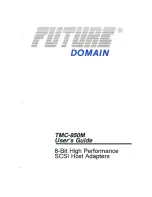
382 Configuring the PID format
Impact of changing the fabric PID format
If your fabric contains switches that use Native PID, it is recommended that you change the format to Core
PID before you add the new, higher port count switches and Directors. Also, it is recommended that you
use Core PID when upgrading the Fabric OS version on 2000 and 3000 series switches.
Depending on your situation, the PID change might or might not entail fabric downtime:
•
If you are running dual-fabrics with multipathing software, you can update one fabric at a time without
disrupting traffic. Move all traffic onto one fabric in the SAN and update the other fabric. Then move
the traffic onto the updated fabric, and update the final fabric.
•
Without dual-fabrics, stopping traffic is highly recommended. This is the case for many routine
maintenance situations, so dual-fabrics are always recommended for uptime-sensitive environments. If
your fabric contains devices that employ static PID binding, or you do not have dual-fabrics, you must
schedule downtime for the SAN to change the PID format.
You can find more details on the impact of PID changes in the following publications, which are available
at :
http://www.hp.com
•
Brocade SilkWorm Design, Deployment, and Management Guide
(Publication Number: 53-0000366)
•
Brocade SAN Migration Guide
(Publication Number: 53-0000360)
The following sections describe various impacts of PID format changes in greater detail.
Host reboots
In some Fibre Channel SAN environments, storage devices and host servers are bound to the host
operating system by their PIDs (called their
Fibre Channel addresses
). In these environments, the hosts and
target HBAs in a SAN need to know the full 24-bit PIDs of the hosts and targets they are communicating
with, but they do not care how the PIDs are determined. But, if a storage device PID is changed, the host
must reestablish a new binding, which requires the host to be rebooted.
With the introduction of the 4/16 SAN Switch and 4/8 SAN Switch, SAN Switch 2/8V, SAN Switch
2/16V, SAN Switch 2/32, and SAN Switch 4/32 switches and the Core Switch 2/64, SAN Director
2/128, and 4/256 SAN Director, the Native PID format used in earlier switches was supplemented with
the Core PID format, which is capable of addressing higher port counts. Changing from Native PID format
to Core PID format changes the PID, which requires hosts that use port binding to be rebooted.
Static PID mapping errors
If you can avoid using drivers that employ static PID binding, you should do so.
With the WWN or dynamic PID binding most typically used with drivers, changing the device’s PID does
not affect the PID mapping. However, before updating the PID format, it is necessary to determine whether
any devices in the SAN use static PID binding.
For those few drivers that do use static PID binding, changing the PID format breaks the mapping, which
must be fixed either by rebooting the host or by using a manual update procedure on the host.
To correct mapping errors caused by static PID binding, refer to the following sections:
•
See ”
Evaluating the Fabric
” on page 278 for details on finding devices that use static PID binding. Then
refer to ”
Online update
” on page 386 or ”
Offline update
” on page 387 for recommendations.
•
Refer to ”
Converting port number to area ID
” on page 391 for instructions.
Changes to configuration data
Table 91
lists various combinations of before-and-after PID formats, and indicates whether the
configuration is affected.
Summary of Contents for AE370A - Brocade 4Gb SAN Switch 4/12
Page 18: ...18 ...
Page 82: ...82 Managing user accounts ...
Page 102: ...102 Configuring standard security features ...
Page 126: ...126 Maintaining configurations ...
Page 198: ...198 Routing traffic ...
Page 238: ...238 Using the FC FC routing service ...
Page 260: ...260 Administering FICON fabrics ...
Page 280: ...280 Working with diagnostic features ...
Page 332: ...332 Administering Extended Fabrics ...
Page 414: ...398 Configuring the PID format ...
Page 420: ...404 Configuring interoperability mode ...
Page 426: ...410 Understanding legacy password behaviour ...
Page 442: ...426 ...
Page 444: ......
Page 447: ......
















































